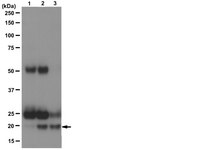Ror2/Frizzled complex mediates Wnt5a-induced AP-1 activation by regulating Dishevelled polymerization.
Nishita, M; Itsukushima, S; Nomachi, A; Endo, M; Wang, Z; Inaba, D; Qiao, S; Takada, S; Kikuchi, A; Minami, Y
Molecular and cellular biology
30
3610-9
2009
Mostrar resumen
The receptor tyrosine kinase Ror2 acts as a receptor or coreceptor for Wnt5a to mediate Wnt5a-induced activation of the Wnt/JNK pathway and inhibition of the beta-catenin-dependent canonical Wnt pathway. However, little is known about how Ror2 cooperates with another receptor component(s) to mediate Wnt5a signaling. We show here that Ror2 regulates Wnt5a-induced polymerization of Dishevelled (Dvl) and that this Ror2-mediated regulation of Dvl is independent of the cytoplasmic region of Ror2. Ror2 can associate with Frizzled7 (Fz7) via its extracellular cysteine-rich domain to form a receptor complex that is required for the regulation of Dvl and activation of the AP-1 promoter after Wnt5a stimulation. Suppressed expression of Fz7 indeed results in the inhibition of Wnt5a-induced polymerization of Dvl and AP-1 activation. Interestingly, both the DIX and the DEP domains of Dvl are indispensable for Dvl polymerization and subsequent AP-1 activation after Wnt5a stimulation. We further show that polymerized Dvl is colocalized with Rac1 and that suppressed expression of Rac1 inhibits Wnt5a-induced AP-1 activation. Collectively, our results indicate that Ror2/Fz receptor complex plays an important role in the Wnt5a/Rac1/AP-1 pathway by regulating the polymerization of Dvl. Artículo Texto completo | 20457807
 |
HFE modulates transferrin receptor 2 levels in hepatoma cells via interactions that differ from transferrin receptor 1-HFE interactions.
Chen, J; Chloupková, M; Gao, J; Chapman-Arvedson, TL; Enns, CA
The Journal of biological chemistry
282
36862-70
2007
Mostrar resumen
Mutations in the transmembrane glycoproteins transferrin receptor 2 (TfR2) and HFE are associated with hereditary hemochromatosis. Interactions between HFE and transferrin receptor 1 (TfR1) have been mapped to the alpha1- and alpha2-helices in HFE and to the helical domain of TfR1. Recently, TfR2 was also reported to interact with HFE in transfected mammalian cells. To test whether similar HFE residues are important for both TfR1 and TfR2 binding, a mutant form of HFE (W81AHFE) that has an approximately 5,000-fold lower affinity for TfR1 than HFE was employed. As expected, W81AHFE does not interact with TfR1. However, we found that the same mutation in HFE does not affect the TfR2/HFE interaction. This finding indicates that the TfR2/HFE and TfR1/HFE interactions are distinct. We further observed that, unlike TfR1/HFE, Tf does not compete with HFE for binding to TfR2 and that binding is independent of pH (pH 6-7.5). TfR2-TfR1 and HFE-HLA-B7 chimeras were generated to map the domains of the TfR2/HFE interaction. TfR1 and HLA-B7 were chosen because of their similar overall structures with TfR2 and HFE, respectively. We mapped the interacting domains to the putative stalk and protease-like domains of TfR2 located between residues 104 and 250 and to the alpha3 domain of HFE, both of which differ from the TfR1/HFE interacting domains. Furthermore, we found that HFE increases TfR2 levels in hepatic cells independent of holo-Tf. | 17956864
 |









